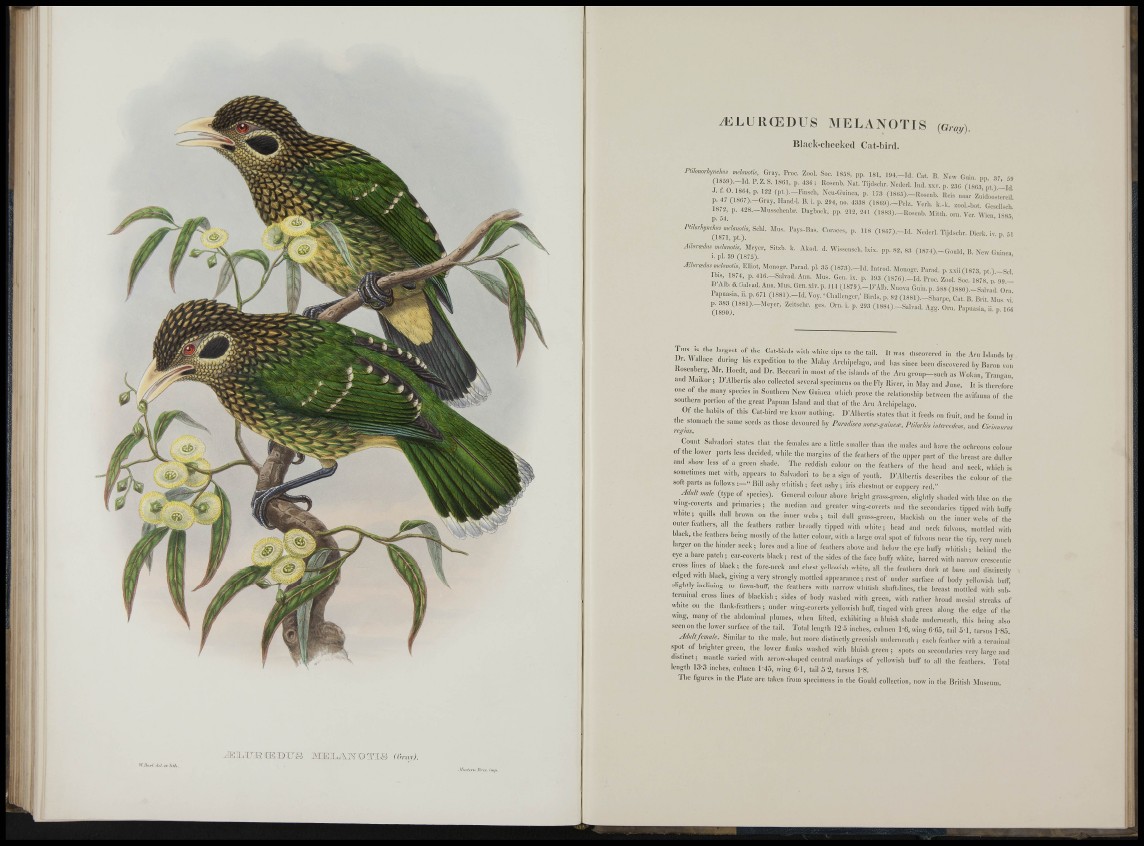
I'f i
I' '
j ' l i / i n i CR-DTrs oa ' j a <r,my).
ir Ih.ri Ifti, .
T E L U R C E D U S MELANOTIS (GRCAY),
Blaclt-clieeked Cat-bird.
PtUonorhjnclm, mdanotw, G.ay, Proc. Zool. Soc. 18:,S, pp. 181, Cat B New Gm„ nn r„
(18o<,).-Id. P.Z.S. 18<n, p. 430; Rosenb. Nat Tijclschr. Nederl. l„d. x.v. p. 23« ( 0 V '' U
18^2, p. 428.-ML,sschenbr. Dagbock, pp. 213, 241 (18S3).-Rosenb. Mitth. on,. Vor. Wien, 1880,
Mus. Pays-Bas, Corace«, p. 118 (18fi7).-Id. Nedcri, Tijdsdn-. Dicrk. iv. p
v_1871, pt.). ^
P P - ( 1 8 7 . 1 ) . - G o u l d , B . New Guinea
1. pi. 39 (^IS/i)^. *
JEh,rced,i„„d„otis, Elbot, Monogr. Parad. pi. 3S (1873) . - Id. lutrod. Moaogr. Parad. p.xxii(]873 ptWScI
' " n i 8 7 < 0 , - I d . P , . o o . Z o c I . S c c . 1878, i l '00. -
D Alb. & Salvad. Ann. Mus. Gen. x h . p. 114 Cl87fl).-D'Alb. Nuova Guin. p, 588 (18S0) . -Salvad Orn
' M ' i'- (I««l3-Sharpe, Cat. B. B.-i, Mu. vi!
(189o; "" Agg. Orn. Papuasia, ii. p. I M
f i l l s IS the largest of the Cat-hirds with white tips to the tall. It wms cllscovc-e.l in the An, Islands hy
Ur. \Valh,ce dunng h,s e.xpedition to the Malay Arehipelago, and has sinee hecn discovered hy 15aron vo,",
Uosenhero, Mr Hoedt, and Ur. Beceari in most of the islands of the Aru gronp-such as Vrokan, Tran^an
and Madior ; D'Albertis also collected several specimens on the Fly River, in May and June. It is therefore
one of the many species in Southern New Guinea which prove the relationship between the avifauna of the
southern portion of the great Papuan Island and that of the Aru Archipela;.o.
Of the habits of this Cat-bird we know nothing. D'Albertis states that^t feeds on fruit, and he found iu
"«"«--g^'now, PiUorhk ¡„tencdcm, and Cinnnurm
Count Salvaclori states that the females are a little smaller thau the males and have the ochreous colour
of the lower parts less decided, while the margins of the fealhers of the upper part of the breast are duller
and show less of a green shade. The reddish colour on the feathers of the head and neck which is
sometimes met with, appears to Salvador! to he a sign of youth. U'Alhertis describes the colour of the
soft parts as follows Bill ashy whitish ; feet ashy ; iris chestnut or cop|,ery red."
Adult male (type of species). General colour above bright gra,ss.green, slightly shaded with blue on the
wmg-eoverls and primaries ; the median and greater wing-eoverts and the seeindaries tl|,ped will, hnlfy
w h i t e ; quills dull brown on the inner webs; tail dull grass-green, blackish on the inner webs of the
outer feathers, all the feathers rather broadly tipped with white; head and neck fulvous, mottled with
black, the feathers being mostly of the latter colour, with a large oval sj.ot of fulvous near the tip, very much
hu-ger on the hinder neck ; lores and a line of feathers above and below ihe eye bnffy whitish ; behind the
eye a bare patch ; ear-eoverts black ; rest of the sides of the face bully white, barred with narrow crescentic
cross lines of black; the fore-neck and chest yellowish white, all the feathers dark at base and distinctly
edged with black, givmg a very strongly mottled a,,|,earance ; rest of under surface of body yellowish bulF,
shg-hfly melinmg to fawn-bulf, the fealhers with narrow whitish shaft-lines, the breast niotlled with sub'
termmal cross lines of blackish ; shies of body washed with green, with rather broad mesial streaks of
white on the flank-feathers ; under wIng-coverts yellowish hulf, tinged with green along the edge of the
wing, many of the abdominal plumes, when lifted, e.-ihibiting a bluish shade underneath, this bein-.- also
seen ou the lower surface of the tail. Total length 12 5 Inches, eulmen 1-0, wing 0 05, tail 51, tarsnri-85.
Adult female. Similar to ihe male, hut more distinctly greenish underneath ; each feather with a terminal
spot ol brighter green, the lower flanks washed with bluish green ; spots on secondaries very large ami
distinct; mantle varied with arrow-shaped central markings of yellowlsli buff to all the feathers. °Total
length 13-3 inches, eulmen 1-45, wing O'l, tail 5 2, tarsus I'S.
The figures in the Plate are taken from specimens in the Gould collection, now in the British Museum.